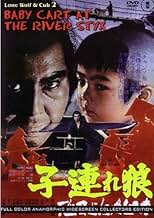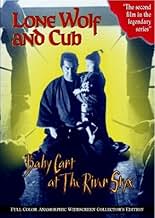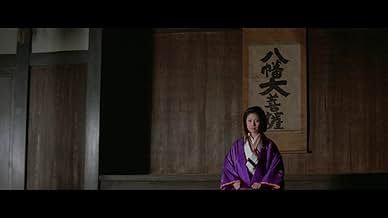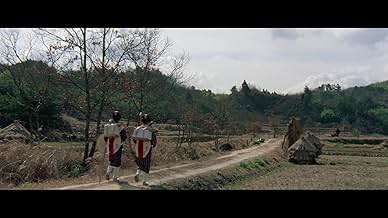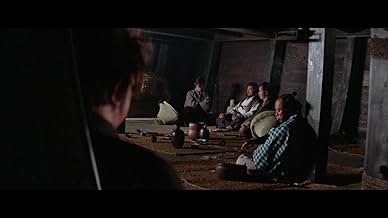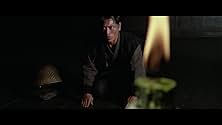Agrega una trama en tu idiomaTrailed by a clan of female ninja, Ogami is paid to assassinate a clan traitor accompanied by three killers known as the Gods of Death.Trailed by a clan of female ninja, Ogami is paid to assassinate a clan traitor accompanied by three killers known as the Gods of Death.Trailed by a clan of female ninja, Ogami is paid to assassinate a clan traitor accompanied by three killers known as the Gods of Death.
- Dirección
- Guionistas
- Elenco
- Mitsugu
- (as Kanji Ebata)
Opiniones destacadas
In this film, Itto continues his journey of vengeance with his young child along for the ride, rolling along in a cleverly weaponized wooden stroller. (Never before has a toddler been complicit in so many killings!) It's a fun movie for the mindless action, but it never really goes beyond that. At times the movie seems like it wants to be a more serious film, but then it veers back to a perpetually nonchalant Itto effortlessly slaying would-be killers along the road.
Overall, it felt like a movie attempting to bridge genres without ever cleanly landing in the one that fit.
This one has the Lone Wolf and his Cub still enjoying the "misadventures" of samurai-for-hire, and of course their quest for vengeance against the Yagyu clan that initially betrayed them. Some intriguing enemies in this one includes a band of female ninjas and the "Gods Of Death". There is also the requisite side story of Itto's "hit of the day"...
This one has some pretty fast-and-furious fight scenes and is probably the most action packed of the series. Again, like the other entries, good acting, great sets and costumes, beautiful camera-work, and the almost magical but extremely unorthodox "chemistry" between father and son are not to be missed. Highly Recommended 9/10
First few minutes produce a stunning sequence of action mis-en-scene. Baby Cart at the River Styx(1972) is the best of the six film series because of complex character development, interesting story, and outstanding action sequences. The Chimes heard by Ogami Itto and his son, Daigoro during early moments of film are a reminder for them of their painful past. Humorous moment occurs when an owner of a hotel inn takes in Itto and son(Lone Wolf gave him gold pieces to watch over) after thinking of not taking them in moments earlier. There is a brilliant 360 to 180 degree pan of the camera that features an effective tight close up to display expressions of intuition from faces of Ogami Itto and Daigoro.
Places a little more focus into the code and demeanor of Ogami Itto than Part One. Ogami Itto as the Lone Wolf lives by Meifumado as a way towards restoring his family name while at the same time take revenge on the Yagyu clan. Ogami Itto kills without emotion yet a shed of humanity is somewhere within his soul. He is an action character of three dimensional depth that is rare for an action picture. Ogami Itto intriques me as a character of graphic novels and for this instance film because of his strong paternal presence.
Introduces some tough female ninja assassins that Lone Wolf & Cub have to go up against. They seem to be untouchable after dispatching a volunteer of the Kurokuwa group until the female warriors face off with Ogami Itto. Ogami Itto is one tough and determined opponent as the female ninja assassins find out when the majority of this group but one is killed off. The face off between Ogami Itto and Sayaka, the leader of the female assassin group successfully played by Kayo Matsuo has a surreal feel to it. Ogami Itto walking through a path of bodies with a baby cart that has a vegetable stuck in the middle front is a nice comic touch.
The confrontation between Lone Wolf & Cub and the Shogunate's Kurokuwa Ninja group is a combo of artful violent imagery and brilliantly smooth editing. This moment flows smoothly in a way that is hypnotic to the eye and mesmerizing to the brain. Although the scene does have it share of graphic violence, there is never a crude feel in the action as at moments in Sword of Vengeance(1972). Fantastic use of cuts and dissolves to make this moment one of the best action scenes from the first two films. The cinematography used in the action moves with graceful steps.
Lone Wolf and Cub:Baby Cart at the River Styx(1972) really gets at the heart of the story with its complex father/son relationship. The father/son relationship of Itto and Daigoro is what has made the Lone Wolf & Cub stories for so many people. Ogami Itto and Daigoro are tied together by an unbreakable bond that is indescrible in words. The bodily expressions tell more about the relationship of Ogami Itto and Daigoro than any sentence could ever do. An example of this notion happens when the leader of the Kurokuwa Ninja threatens to kill Daigoro is Itto does not give up.
The graphic violence is much higher here than in Sword of Vengenace(1972). The violent battle scenes of BCATRS stir around with stylistic expression. Maybe not as artisticly refined as in samurai films by Akira Kurosawa, but the violent battle scenes at least never feel bland or boring. I can see where filmmakers like John Woo got their influences when I watch the battle scenes of LW&C:BCATRS(1972). The graphic violence in part two and the other films in the series must have played an important influence on the bloody violence in Lucio Fulci's gothic chillers.
Ogami Itto and Daigoro follow a path of blood and corpses that is steeped in tragedy. In living by Meifumado, they are as one who hold a future that is bleak and hopeless. Only when they completely destroy the Yagyu Clan can the Lone Wolf and Cub return to a path of a hopeful future. For Daigoro, dying in the well would have been more merciful than living to an unknown future. Daigoro represents the good, kind side of Ogami Itto whom without would just be cold blooded and ruthless. The tragic path of the two is an element that is fascinating.
The most formidable opponets of Ogami Itto are the Bentenri brothers from part two. The duel between the brothers and the God of Death in the sandy desert is Leonesque. The head splitting moment is the creme de la creme of the duel. Tomisaburo Wakayama for this moment reaches the larger than life heights of Toshiro Mifune. Breathtaking samurai duel with excellent scenery that would have made Sergio Leone proud.
The actors who play the Masters of Death give their characters an unique quirk to make the Bentenrai brothers fascinating villains. One of the actresses(Michie Azuma) who plays a female ninja assassin would have a more substanical role as topless female assassin in Lone Wolf & Cub:Baby Cart in Peril(1972). Part One and Part two of LW&C use identical imagery. Better directed than the first film with fewer slow moments. Lone Wolf & Cub:Baby Cart at the River Styx(1972) stays true emotionally to the graphic novel that the film is based on.
I was taken into this film from the start and was just amazed by how influential these kind of films have been for so many years and when you watch them you will see why.
There were a couple of funny moments relating to the little boy and his participation in the various battles. The use of the boy for some humor was a plus.
The fighting scenes were mostly good, but not as good as the Zatoichi movies which I love and have seen them all. The bloody effects were pretty bad in some scenes, as the injured (killed) samurai sometimes started bleeding many seconds after they were stabbed or sliced. In one scene, Lone Wolf impales two guys at the same time. One of them immediately starts spraying lots of blood from his wound. The other guy gets a trickle of blood dripping out. It would have been more impressive if the double-impalement lead to double sprays of blood.
Several heads were sliced open, and the last one looked like a venus flytrap popping open, and there were no brains, eyes, or other material visible, it looked totally silly. Then a single spray of blood shot straight up into the air from the middle of the head. Laughable and really bad special effects.
Otherwise, the film was pretty good. It had a lot of action, some good story lines, and some humor.
¿Sabías que…?
- TriviaThe distinctive hats worn by the Gods of Death, are a traditional Japanese straw hat often associated with ronin. The style of hat is known as roningasa. 'Ronin' meaning masterless and wandering samurai, and 'gasa' meaning hat.
- ErroresWhen Ogami and Daigoro are walking through the forest shortly before being attacked by Kurokawa and his ninja henchmen (around the 31:30 mark), cars can be seen driving by in the background on the left side of the frame.
- Citas
Benma Hidari: [Ogami Itto has bested him and slashed him across the neck with a sword; blood is starting to flow from the wound, making a certain sound] My neck... my own neck... It sounds like it's wailing. My neck was sliced open diagonally. The cut wails like a cold winter wind. They call it "mogari-bue," - the whistle of a fallen tiger. I've always wished to kill someone, just once, and create such a fine cut and to sing this tune. Now I'm hearing it from my own neck. What a laugh.
[rolls over dead, with blood spurting out from his neck wound onto the sand]
- ConexionesEdited into Asesino Shogun (1980)
Selecciones populares
- How long is Lone Wolf and Cub: Baby Cart at the River Styx?Con tecnología de Alexa
Detalles
- Fecha de lanzamiento
- País de origen
- Idioma
- También se conoce como
- Lone Wolf and Cub: Baby Cart at the River Styx
- Productoras
- Ver más créditos de la compañía en IMDbPro
Contribuir a esta página


